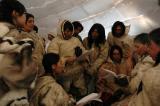When your work speaks for itself, don't interrupt - by Norman Cohn

We have been asked: Who is the intended audience for The Journals of Knud Rasmussen?
As community-based filmmakers our first audience is Inuit of Igloolik and other Inuit or indigenous people who recognize the story as their own. The Journals takes on three essential obligations to this audience: first, to carry forward Avva's life story, a contract the shaman made with Rasmussen who passed it on to us. The film is foremost an armature enclosing eighteen minutes Avva tells his story and beliefs, a dramatic monologue as much in the history of Inuit storytelling as in the history of film or art.
Second, to represent Avva and his family in that moment with dignity, honoring the intelligence, elegance, beauty and power of the life they were about to lose.
Third, to acknowledge what happened without divisiveness or blame. People are caught in a wave of historical momentum where we choose not to judge right or wrong.
As video artists in the first decades of a medium whose distinct character finally reveals itself in high-definition, we have responsibilities to a second, universal audience of which Inuit are a part. We explore changes in storytelling made possible by unique properties video brings to narrative representation. In particular, digital transparency allows visualizing Time in three dimensions - duration, quality and simultaneity - with an illusion of actuality that lends human emotions new urgency. As agents in our own lives, and spectators of others, we recognize authentic meaning only in emotions experienced in 'real time'; that is, not the fake and fractured time of conventional filmmaking but the three-dimensional time of real life.
Bringing the heightened awareness of real time to dramatic storytelling enables empathic identification between character and witness at a level of meaning where social action becomes possible. Made for Inuit The Journals of Knud Rasmussen brings Avva's story forward with dignity and generosity; while for the universal audience The Journals also brings video art forward where emotion is a vehicle of time travel whose destination is social change.
I began working with video in 1970 when its originating dialectics were political: access and exclusion, community and authority, process and product, with the elusive imagined goal to combine community-based process and broadcast-quality product in the same exemplary work. This unified theory imagines audience with its own dimensions or rings, where any individual or group may occupy inner and outer rings at the same time. Whether viewing themselves or strangers, no one watching The Journals of Knud Rasmussen can ignore how and by whom it was made, at the farthest reach of the known world. Access, community and process are rendered visible in the final product; The Journals proves art already is change, to anyone able to see it.
In the 1970's and early 80's I made a series of video portraits following people I knew around ordinary days of their lives. The first and sometimes only audience for these portraits was the person and I watching together at the end of the day of unedited filming. I called this series How We Lived. How else to represent loss but to see life?
- 11183 lecturas




